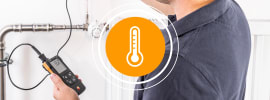Pasteurization: What you need to know
The safety of food is taken for granted by consumers. The preservation of food via the process of pasteurization in autoclave pots, full-water immersion or shower type autoclaves or retorts is essential for this.

Inactivation of pathogenic germs to increase food shelf-life with complete preservation of nutrients via a core temperature of between 60 °C and 100 °C
Systems should be validated once a year
1: Warm-up phase
The water temperature is brought to the previously defined pasteurization temperature of +95 °C, for example, in an autoclave pot.
2: Pasteurization
The pasteurization temperature is reached throughout the system and there is homogeneous temperature distribution. The process duration and pasteurization temperature vary depending on the product.
3: Cooling phase
The product is removed from the autoclave pot and brought to room temperature. Depending on the product and system type, clean-in-place cleaning (CIP) is necessary to prevent the formation of micro-organisms in the system.
Checking and regular verification as to whether the pasteurization process is effective
Determination of the correct hold times/pasteurization temperatures and the P-value
Measurement of temperatures at the coldest point in the process
Correct placement of the data logger is crucial for ensuring the reliable killing of germs in the product
HACCP
testo 191 HACCP data logger system consisting of HACCP data loggers, software and multifunction case
Measuring range -50 to +140 °C
Small battery for placement in small containers
A wide range of accessories allows optimal positioning of loggers for the core temperature measurement
Simple calculation of P-value and holding phase by the software

How can our data logger systems help you specifically?
Contact
The right data logger system for your pasteurization processes
The testo 191 HACCP data logger system

Downloads for the testo 191 HACCP data logger system
Whitepaper, application example, product brochure and factsheet






























